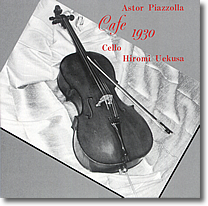Astor Piazzolla "Cafe 1930" /植草ひろみ植草ひろみが1997年に発表し、各方面で絶賛されたピアソラ作品集
|
|

植草ひろみ
1997 H&M HU-001
|
バンドネオンの名手でもあり数々の名曲と名演を残したアストル・ピアソラがこの世を去ってから、
多くのクラッシックの演奏家が彼の作品を取り上げ演奏するようになってきた。 彼の作品はタンゴ、そしてジャズ、クラッシックとジャンルを問わないピアソラの世界なのである。 私が初めて彼の作品に触れたのは1985年。 ブエノスアイレスの冬(Invierno-Porteno)を聴いたのが始めである。 忘れがたいメロディー、そして心に響くバンドネオンの音、 未だ見ぬブエノスアイレスヘの思いを馳せたのを覚えている。 その後、ピアソラがチェリストのムスティスラフ・ロストロポーヴィチの為に書いた曲があるのを知り、 出会ったのが「Le Grand Tango」である。 「Cafe 1930」と「Night Club 1960」は本来ギターとフルートの為に書かれた4曲から成る「タンゴの歴史」という作品の中の2曲である。 「Camorra 3」は、1989年に書かれた近作で、喧嘩がテーマになっているらしい。 Since the recent death of Astor Piazzolla, a renown bandoneon player, many well known musicians has began to perform his works again. His music combines the genres of classical, jazz and tango, but goes beyond them to create a new sound, which can be only classified as "Piazzolla Tango." I first encountered Piazzolla's music listening to "Invierno Porteno" (Winter of Buenos Aires) in 1985. The piece has an unforgettable melody that cannot help but move one's heart, thanks to the captivating sound of the bandoneon. The piece began to stir my passion for Buenos Aires, a city I had never visited. Soon after, I was introduced to "Le Grand Tango", a remarkable piece of music written by Piazzolla for cellist Mstislav Rostropovich. "Cafe 1930" and "Nightclub 1960" are part of a collection by Piazzolla named "History of Tango". They were originally written for flute and guitar "Camorra 3" was one of Piazzolla's last pieces, written in 1989. It theme is based on a fight chant. 「Astor Piazzolla」のページでこのCDの内容が聞けます。 |
Cello :Hiromi Uekusa Wayne Cook Recorded May, 1997, 完売いたしました。 |
|
| ブエノスアイレスでの思い出の写真とともに(ピアソラのお墓も)ダイジェスト版で見て聴いて頂けます! |
|
